1. Introduction
Plasmon
UDO30I external SCSI Drive -
Page 1
Introduction
 Plasmon
announced back in November of 2003, the UDO technology as a new
standard for professional optical storage, aimed at both large and small
companies looking
for
an easy archival storage system. Based on ultra density,
phase change blue laser technology, it is the recognized successor to 5.25
inch MO (Magneto Optical) storage and is available in both Rewritable and
true
Write Once media
formats. Our review has the goal of introducing UDO technology, and to trial
how it works.
Plasmon
announced back in November of 2003, the UDO technology as a new
standard for professional optical storage, aimed at both large and small
companies looking
for
an easy archival storage system. Based on ultra density,
phase change blue laser technology, it is the recognized successor to 5.25
inch MO (Magneto Optical) storage and is available in both Rewritable and
true
Write Once media
formats. Our review has the goal of introducing UDO technology, and to trial
how it works.
- UDO Technological Background
Plasmon`s
UDO drive is one of the first blue-violet laser and phase change products
available on the market, offering the next generation of professional
optical storage devices. UDO uses non contact recording to provide robust
and reliable performance. Blu-Ray and PDD (Professional Disc for DATA from
SONY)
lasers use 0.85 numerical aperture (NA), while UDO lens has 0.7 NA for
higher reliability and 0.1 mm cover layer for disc protection. The opto-mechanical
assembly for the UDO drive comes from Asahi Pentax, a leading manufacturer
of opto-mechanical assembly for 5.25" opto-mechanical drives.
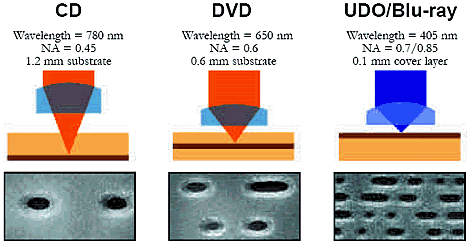
- Why would someone need UDO Technology?
According to Plasmon, archival storage solutions are important for all organizations,
large and small, everywhere round the world. The following changes in business
practices and government
oversight make an archival storage strategy essential:
- Regulation – government and industry agencies have increased enforcement
of existing regulations controlling data retention and instituted new,
more stringent controls.
- Litigation – the financial and management burden
of litigation continues to grow. Providing authenticity and well-documented
audit trails are crucial
elements for protecting any organization.
- Benefits – organizations are
using long-term knowledge resources to make better decisions, lower costs,
reduce time-to-market and improved customer
loyalty.
Authenticity and Trustworthiness
UDO provides absolute data authenticity for regulatory compliance or for any
application where archived information must remain 100% unchanged. UDO’s
patented Phase Change recording process permanently alters the molecular structure
of true Write Once media, ensuring data integrity at the most fundamental level.
Long-term Data Retention
UDO has been designed to provide decades of dependable data retention. A highly
stable recording surface delivers media life in excess of 50 years, minimizing
the frequency of data migration and virtually eliminating media maintenance.
High Capacity and Scalability
Rapidly growing archive data volumes demand solutions with high initial capacity
and flexibility to scale over time. Blue laser technology gives 30GB UDO a
three-fold increase in storage capacity compared to previous generation MO
(Magneto Optical) and DVD technologies. The removability of UDO cartridges,
combined with the on-line media management capabilities of optical storage
libraries, means scalability is essentially unlimited.
Rapid Information Access
Knowledge assets are useless if they cannot be accessed when needed. UDO has
fast 25-millisecond random access capability, facilitating timely retrieval
of relevant data.
Low Total Cost of Ownership
UDO has a highly competitive archival storage TCO. With attractively priced
30GB media, the acquisition cost of a UDO library compares favorably with much
less reliable tape or DVD solutions and costs a fraction of hard disk-based
systems. UDO’s ISO standard 5.25 inch media cartridge, which permits
the use of MO and UDO media in the same library, eliminating the necessity
for migration from 9.1 MO media. Planned introductions of backward-compatible
60GB and 120GB UDO drives guarantee investment protection and minimize future
migration expense.
- Media Specifications
 The
drive uses Plasmon 5.25 inch double sided UDO media cartridges with 30 GByte
capacity. These are available in both true write once and rewritable media
types. They use the same form factor as MO (Magneto Optical) media but are
not compatible with MO drives, nor are MO media compatible with
UDO drives. New UDO media must be formatted before being used, and behave
like Removable/Floppy disk drive.
The
drive uses Plasmon 5.25 inch double sided UDO media cartridges with 30 GByte
capacity. These are available in both true write once and rewritable media
types. They use the same form factor as MO (Magneto Optical) media but are
not compatible with MO drives, nor are MO media compatible with
UDO drives. New UDO media must be formatted before being used, and behave
like Removable/Floppy disk drive.
Disk
Diameter |
130 mm |
Disk
Thickness |
2.4 mm |
Cartridge
Size |
5.25 inch - ISO Standard
135x153x11mm |
Capacity |
30 GB |
Sector size |
8 KB |
Number of
user sectors/side |
1,838,652 |
Data area |
27.0-62.5 mm |
Recording
layer |
Phase change |
Recording
format |
Land & Groove |
Recording
side |
Both sides |
Recording
density |
7.4 Gb/in |
Media
layers |
1 |
Data encoding |
RLL (1,7) |
Rewrite cycles
(Rewritable Media) |
10,000 |
Media life |
50+ years |
Archival
Temperature |
5-55C |
Archival
relative humidity |
3-90% |
The media cartridges, physically identical to 5.25" MO,
provide compatibility with current library automation systems but as we said
before, backwards compatibility is not available with current MO
technology. UDO`s media supports both true WORM (Write Once Read Many) and
rewritable (RW)
media
types
thanks
to phase change recording technology while providing 50 years of data life.
For 30 GB UDO-R media the cost is $60 which should decrease to $15 by the release
of the third generation products, according to the company.
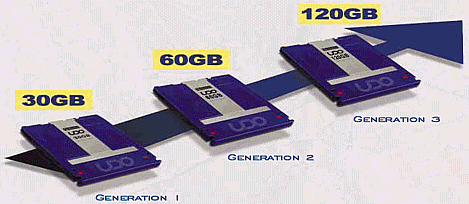
UDO
MEDIA
|
Generation
1
|
Generation
2
|
Generation
3
|
Capacity
|
30
GB
|
60
GB
|
120
GB
|
Transfer
Rate
|
up
to 8 MB/s
|
up
to 12 MB/s
|
up
to 18 MB/s
|
RPM
|
2000
RPM
|
3000
RPM
|
3600
RPM
|
Avg
Seek Time
|
25
msec
|
25
msec
|
25
msec
|
Numerical
Aperture
|
0,7
|
0,7
|
0,85
|
Media
Layers
|
1
|
2
|
2
|
Encoding
|
1,7
|
1,7
|
ML
|
Sector
Size
|
8
KB
|
8
KB
|
8
KB
|
SCSI
Transfer Rate
|
80
MB/s
|
80
MB/s
|
80
MB/s
|
Load
Time
|
5
sec
|
5
sec
|
5
sec
|
Unload
Time
|
3
sec
|
3
sec
|
3
sec
|
MSBF
|
750,000
|
750,000
|
750,000
|
2. The Drive
Plasmon
UDO30I external SCSI Drive -
Page 2
The
Drive
 The
device comes with UDO drive resource CD, 68pin Micro-D wide SCSI cable, a SCSI
terminator,
power cable and two 30 GB UDO media, one
rewritable and
one write once read many (WORM).
The
device comes with UDO drive resource CD, 68pin Micro-D wide SCSI cable, a SCSI
terminator,
power cable and two 30 GB UDO media, one
rewritable and
one write once read many (WORM).

On the front of the drive, there are from left to right, the
UDO logo, the emergency eject hole and the eject button. Above it there
are two leds, the left one is the active (Amber) and the right one is the ready
(Green).

On the back of the drive from left to right there is the power
switch below of the SCSI ID
switch, two SCSI-III 68-pin Micro-D connectors above the AC
power connector and the fan/air filter.

The Plasmon UDO30I SCSI drive features
double sided 30GByte (15GB per side) storage on rewritable and write once
media. It uses half height 5.25 inch form factor media cartridges, operating
at Constant Angular Velocity (CAV) with continuous spin at the higher rate
and communicate through a SCSI III connection.
| Host/Interface |
External
Wide Ultra 2 LVD SCSI keyed 68 pin micro-D
|
| Performance |
Rotational Speed: 2160 rpm |
| Media load time:
5 sec |
| Media unload time:
3 sec |
Avg. seek time
(1/3 full stroke): 35 ms
|
| Max. Read Transfer
Rate: 8 MB/s |
Max. Write Transfer
Rate: 4 MB/s (including verify)
|
| Operation |
Error Correction:
Reed-Solomon
|
| Objective Lens Numerical
Aperture: 0.7 NA |
| Laser Wavelength:
405 nm |
| Reliability |
MSBF: 750,000 load/unload
cycles |
| MTBF: 100,000 hours |
| Operating
Conditions |
Operating Temperature:
5 to 45C |
| Operating Humidity:
5 to 90% RH (non-condensing) |
| Drive Orientation:
Horizontal or Vertical |
| Maximum SCSI
transfer rate |
40 MB/s
|
| Buffer memory |
32 MB |
| Dimensions&Weight |
H 41.1 x W 146 x
D 203 mm - 1.5 kg |
- Installation
When the
device was connected to our PC, it was identified as Disk drive "Plasmon
UDO1 SCSI Optical Device" under
WinXP.
It is necessary first to install a hotfix patch prior to inserting the media
into
the
drive.
This step is needed because the UDO drive uses 8KB sector size for optimized
read/write performance across a wide range of file sizes, which Windows does
not support,
even with Windows XP SP1.
The
patch
is supplied
on
the
UDO
drive
resource
CD.
Next, we installed the Software Architects UDO driver Software, also on the
resource
CD.

Also, under drive properties, write mode tab,
we selected cached write mode for increased performance, although direct write
mode is
the safe
choice should the PC lose power or crash.
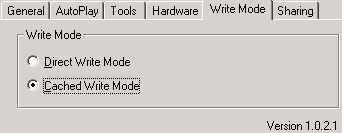
For our tests we are going to use only the RW cartridge as
the Write once media unfortunately for us, was defective and the system
did not recognize it.
3. Reading Tests
Plasmon UDO30I external SCSI Drive - Page 3
Reading Tests
Using
the RW cartridge, the UDO30I operates like a Removable/Floppy device using
UDFS format with a 5.25"
cardridge. Blank media requires a quick format before use. For the test
we copied 6,129 different
files, large and small, from the RW cartridge using drag & drop, to
our hard disk drive. The reading time is listed below while the total
bytes was 13.6 GB.
Drive
Action |
Minutes |
Read |
84 |
The sequential read test was achieved with the SCSI
Mechanic 3.0 utility
with the RW cartridge full of different types of files. We let the test run
for 30 min. in order to obtain more accurate results.
.
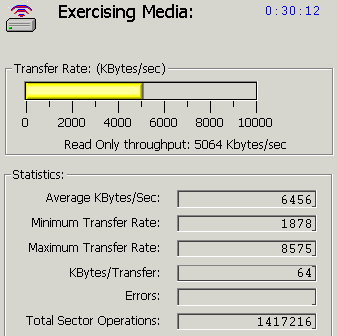
Average
read transfer rate is 6.45MB/s and the maximum is 8.57MB/s.
Using AnalyzeDisk's IPEAK utility
from Intel, we measured the average access time needed when reading
from the drive.
The
Distribution of Read Service Times test uses a large number of samples,
25,000 to be exact, and measures the time taken for random single sector read
requests across
the
entire drive's
surface.
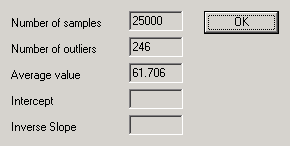

The
average access time is 61.7 ms
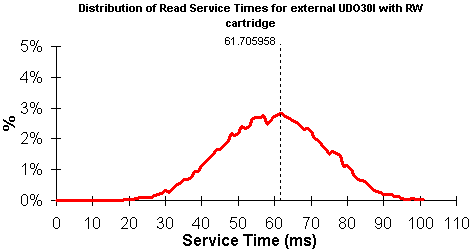
Random reads gave us what can be considered high access
times for read access at
61.7ms when compared to a hard disk for example.
4. Writing Tests
Plasmon UDO30I external SCSI Drive - Page 4
Writing Tests
The write test involves
copying
6,129 different large and small files to the RW cartridge using
drag & drop
and measuring the time taken. The time for writing is listed
below while the total
bytes
transfered was 13.6 GB.
Drive
Action |
Minutes |
Write |
96 |
Sequential write test carried out again with SCSI
Mechanic 3.0
and the RW cartridge full of different kinds of files.
The test needed 30 minutes.
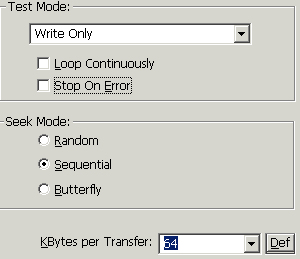
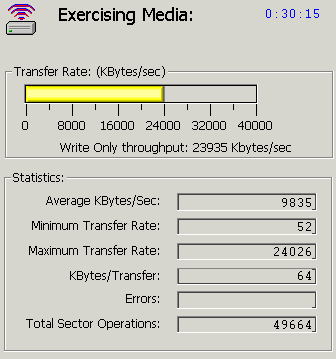
Average write transfer rate is 9.8MB/s with a maximum transfer
rate of 24MB/s.
To
measure the average access time needed when writing
to the drive we again used AnalyzeDisk.
The
Distribution of Write Service Times test, takes 25,000 random single-sector
writes and measures the average access time it takes to writes across the
entire drive's
surface.
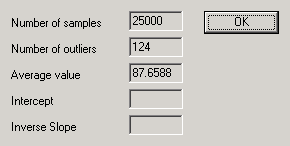
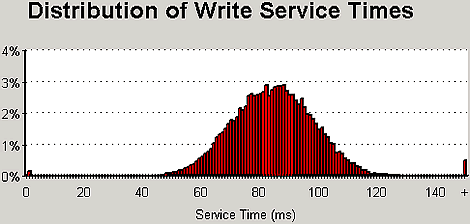
The
average access time is 87.65 ms

Write
access time of 87.65ms is far higher than the company's specifications.
5. Conclusion
Plasmon
UDO30I external
SCSI Drive -
Page 5
Conclusion
|
Pros
|
Cons
|
- High capacity removable disks (30 GB)
- With RW Media operates
like a Removable/Floppy device
|
- Price
- Low read/write speed performance
- OS drivers needs improvement
|
UDO uses its own phase change recording process, offering
one of the most robust storage methods and ensuring data integrity at the
most fundamental level. Target markets for UDO technology include banking,
telecoms,
insurance e.t.c where the need for high reliability in storage is high
(our tests could not confirm whether this device is indeed highly reliable,
since that would only show up with long term useage/testing).
The results reflect low overall performance
with the drive. SCSI Mechanic 3 gave us sequential read transfer of about
6.45MB/s and 9.8MB/s write transfer. Analyze Disk measured average
read access
time of 61.7ms
and average write access time of 87.65ms placing the drive in
the low performance devices category.
When copying, to keep performance high, the manufacturerer
recommends copying up to 1000 to 1200 files per directory at a time. Also,
the user must be sure that there are no other UDF (DVD) file systems installed
as they interfere
with the UDO driver software.
Desktop UDO drives are priced at approximately
$3,200 USD. The price is rather high for end users, but Plasmon is aiming
at the Proffesional market, where reliability is important.
|
Advertising |
|
|